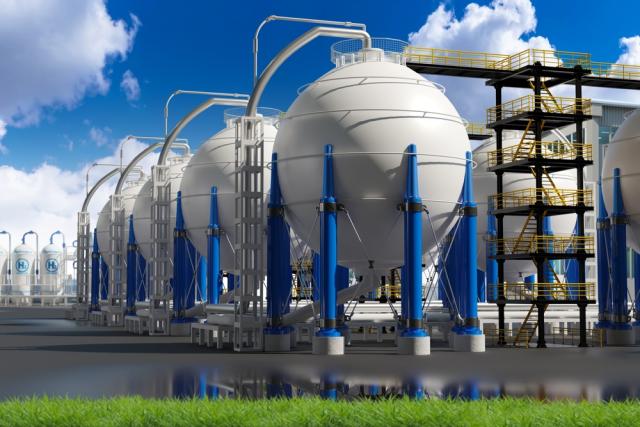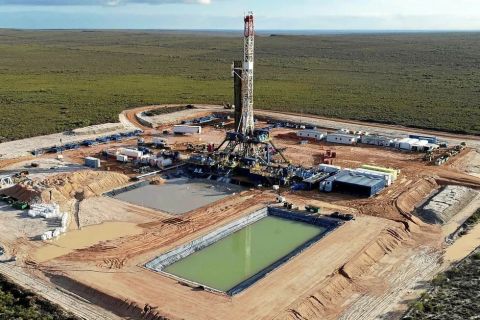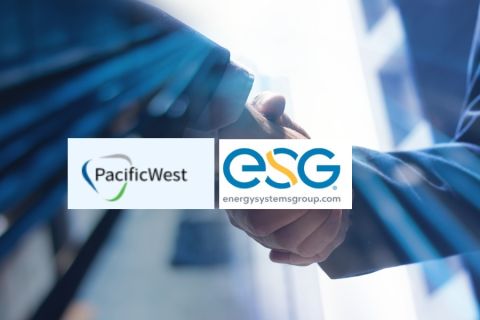
If projects currently in the pipeline come to fruition, low-emissions hydrogen production could reach up to 24 mtpy by 2030, with more than half of it coming from electrolyzers running on renewable energy. (Source: Shutterstock)
In just the past few weeks, a range of North American and global midstream operators, utilities, energy and chemical companies have announced projects to develop commercial hydrogen production and distribution. Notably, investment firms are joining the parade to back startups. With the burgeoning of renewable energy, and the more recent flourishing of carbon capture and sequestration (CCS), the old dig that hydrogen is the fuel of the future – and always will be – may no longer be accurate.
Hydrogen companies are on the move.
Most recently Global Hydrogen Energy announced in mid-May that it will go public as part of a merger with special purpose acquisition company Dune Acquisition Corp. in a deal valued at $112 million. The hydrogen pure-play and carbon-recovery project developer mainly targets renewable waste as feedstock to generate industrial gases to sell.
At the end of April, Xcel Energy, a gas and electric utility company based in Minneapolis, commissioned a detailed assessment of its natural gas system to determine the feasibility of injecting and blending hydrogen into pipelines. Worley, a design and engineering firm based in Melbourne, Australia, won the bid—its second hydrogen-related commission within weeks. Early in the month, the firm was tapped for a preliminary FEED and technical survey by Cadent Gas as part of the East Coast Hydrogen Pipeline project in the U.K.
In mid-April, TC Energy and Chemours signed a memorandum of understanding (MOU) for potential development of two electrolysis-based hydrogen production facilities at or near the chemical company’s Washington Works and Belle manufacturing sites in West Virginia.
Early in April, Exxon Mobil signed a long-term agreement with industrial-gas firm Linde for offtake of CO2 from Linde’s new clean-hydrogen production in Beaumont, Texas. Linde previously announced that it will build, own and operate an on-site complex to supply clean hydrogen and nitrogen to OCI Global’s new world-scale blue ammonia plant. Linde’s facility is expected to start up in 2025 and will be integrated into the company’s Gulf Coast industrial-gas infrastructure.
If all projects currently in the pipeline come to fruition, the production of low-emissions hydrogen could reach 16 million tonnes per year (mtpy) to 24 mtpy by 2030, with more than half of it coming from electrolyzers running on renewable energy, according to the most recent Global Hydrogen Review by the International Energy Agency (IEA).
The IEA projected that completion of all the projects in the pipeline could result in the world’s capacity to produce hydrogen via electrolysers rising to up to 290 gigawatts (GW) in 2030 compared with 0.5 GW in 2021. The report suggests that based on today’s prices, renewable hydrogen could already compete with hydrogen from fossil fuels in regions that have good renewable resources and that currently rely on imported fossil fuels for hydrogen production.
Hydrogen gets integrated
Global Hydrogen was only formed at the start of this year, but William Nance, founder and CEO, has been in the hydrogen industry for several years. He will remain CEO of the combined company, to be called Global Gas Corp., once the transaction with Dune is complete. The business model for Global Gas is to provide hydrogen from multiple sources to multiple users. “We are agnostic to the method of production and to the end-use market,” Nance said.
“The Inflation Reduction Act and the Bipartisan Infrastructure Law increased incentives for hydrogen use as an energy carrier fuel,” Nance said. “We are creating an infrastructure to sell to an emerging base of customers.”
Two large segments of the existing hydrogen industry exist today: the industrial-gas segment, which largely makes use of proprietary infrastructure and distribution networks, and the refining and petrochemical sector, where hydrogen is mostly produced and consumed within the fence line.
Both of those segments have some commercial production, which Global Gas expects to use as part of its supply. The company’s main focus will be on new, green and blue production of hydrogen that will be sold to emerging end-use markets, notably for fuel cells to be used in heavy-haul road, rail, maritime and even aviation transportation. The electrification of passenger cars is expected to remain primarily battery driven.
“The focus is on the book of demand,” said Carter Glatt, founder and CEO of Dune. “Our plan is to form syndicates of offtake agreements; we will also have our own hydrogen production plants. There will be multiple opportunities for revenue. That is the business model. The tax credits and incentives under the new laws are an added benefit, but they are not the basis of our business.”
For example, a municipality may get matching funds for ordering a fleet of hydrogen-fuelled buses. That increases commercial demand for hydrogen, but the incentive is not a direct benefit to the hydrogen supplier. The municipality would buy fuel as it would any fuel.
“We are seeing growing interest globally in both the repurposing of existing natural-gas midstream to transport hydrogen or hydrogen blends, and new dedicated hydrogen pipeline infrastructure,” said Oliver Morgan, vice president of growth and transformation at Worley. “Our customer base with respect to dedicated hydrogen infrastructure is not limited to industrial-gas companies and includes integrated energy companies, midstream operators and gas utilities,” among others.
In projects where hydrogen would be injected into a natural gas line, the intent is to deliver the blend as a combustion fuel or process feedstock because the separation of methane and hydrogen is energy intensive. Hydrogen intended for use in a fuel cell or other elemental use would be delivered as a discrete gas.
The risks
The main pipeline integrity challenge with hydrogen is embrittlement, or hydrogen-induced cracking. That is where hydrogen molecules migrate into steel and lower the stress level required for cracks in the metal to form and propagate.
Key risk factors, Morgan detailed, can include:
- Grade of steel, metals with higher tensile strength are more susceptible to reduction in fracture resistance;
- Hydrogen partial pressure, which is the product of pipeline absolute pressure and hydrogen concentration;
- Pressure cycling, transient imbalances in hydrogen supply and demand, especially with respect to green hydrogen production that relies on intermittent renewable power; and
- Existing defects in the pipeline metal and welds.
“Coatings or linings inside steel pipelines have been suggested as a possible solution for short length,” Morgan added, “but questions remain as to how the operator ensures integrity of the barrier.”
More broadly, Morgan said that “as an organization, we are seeing the low-carbon hydrogen industry enter a period of rapid maturing and growth, with project ambition and scale being a step change from even two years ago. The second clear trend in green hydrogen is the bundling of assets into power-to-x projects, with renewables, hydrogen production and a midstream-connected asset, such as production into sustainable aviation fuel, being co-developed.”
That includes fast-tracking projects through FEED, operational strategy development and supporting projects through final investment decision. “The development of related infrastructure, such as ports and hydrogen pipelines, is also an increasing part of our everyday work,” said Morgan.
In general, the challenge of delivering the infrastructure necessary to support the energy transition will require greater collaboration across value chains than has been the case so far, Morgan cautioned. “That is true for the hydrogen ecosystem, where midstream companies and transmission systems operators will be a critical link between industrial hubs producing low-carbon hydrogen and gas utilities distributing the hydrogen to industrial and perhaps residential consumers.”
Xcel’s study, due to be completed in July, will determine the feasibility of injecting and blending hydrogen into the utility’s 36,000 miles of distribution pipeline and 2,200 miles of transmission pipeline. It will evaluate what percentage of injected hydrogen the system can accommodate, and what upgrades are necessary to optimize the blended quantity.
The U.K. project, led by East Coast Hydrogen, will connect 10 GW of hydrogen production from Humber and Teesside industrial hubs to the gas network. With this project, Cadent aims to connect hydrogen supplies between Humberside and Northampton, potentially creating a 240 km network.
The MOU between TC Energy and Chemours supports the companies’ participation in and goals of the Appalachian Regional Clean Hydrogen Hub in West Virginia. The agreement covers the companies’ interest in developing, building and operating clean hydrogen production and associated infrastructure. The proposed development includes using established proton exchange membrane electrolyzers and using Chemours ion exchange membranes.
Under the MOU, a non-binding off-take agreement for hydrogen produced by the project would be executed, supporting the facility demands of Chemours. Additionally, hydrogen produced in excess of the offtake agreement would be stored and available for loading and shipment to nearby merchant users.
“Working with TC Energy, we’ve conducted hydrogen blend testing at our Washington Works and Belle sites, demonstrating the feasibility of feeding a hydrogen-natural gas blend fuel to existing fired boiler equipment,” said Jonathan Lock, senior vice president and chief development officer at Chemours, in announcing the agreement.
Recommended Reading
Marketed: BKV Chelsea 214 Well Package in Marcellus Shale
2024-04-18 - BKV Chelsea has retained EnergyNet for the sale of a 214 non-operated well package in Bradford, Lycoming, Sullivan, Susquehanna, Tioga and Wyoming counties, Pennsylvania.
Triangle Energy, JV Set to Drill in North Perth Basin
2024-04-18 - The Booth-1 prospect is planned to be the first well in the joint venture’s —Triangle Energy, Strike Energy and New Zealand Oil and Gas — upcoming drilling campaign.
PGS, TGS Merger Clears Norwegian Authorities, UK Still Reviewing
2024-04-17 - Energy data companies PGS and TGS said their merger has received approval by Norwegian authorities and remains under review by the U.K. Competition Market Authority.
Energy Systems Group, PacificWest Solutions to Merge
2024-04-17 - Energy Systems Group and PacificWest Solutions are expanding their infrastructure and energy services offerings with the merger of the two companies.
Chevron, Exxon in Dispute Over Hess Stake in Guyana Oil Block
2024-02-27 - Chevron’s $53 billion deal to buy Hess’ interests in the Stabroek Block offshore Guyana could be derailed as Exxon, CNOOC say they have first rights of refusal on the block’s interests.



